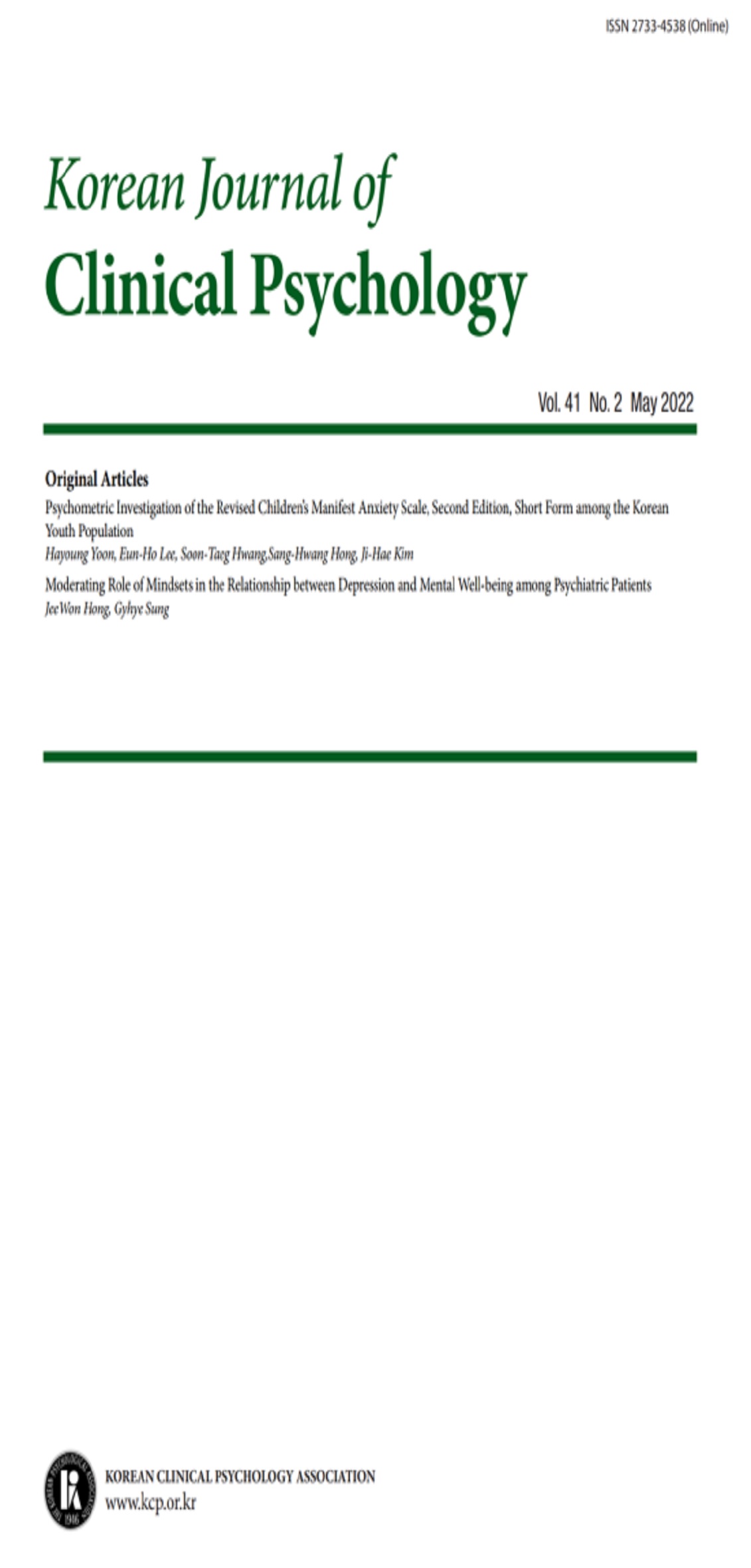open access
메뉴
open access
메뉴 E-ISSN : 2733-4538
E-ISSN : 2733-4538
본 연구에서는 유아기 내재화 및 외현화 문제가 얼마나 안정적으로 지속되는지를 알아보고자 하였다. 이를 위해 만 3세-5세 유아 197명(남아 105명, 여아 92명)을 대상으로 한국판 유아행동평가척도(CBCL 1.5-5)를 사용하여 문제행동을 평가하고 1년 후에 추적 조사를 통하여 다시 한 번 문제행동을 측정하였다. 그 결과, 1년 간격을 두고 동일한 측정도구로 평가한 문제행동 점수의 상관관계 계수가 남아의 경우 내재화 문제 r=.71, 외현화 문제 r=.76, 총 문제행동 r=.77로 높게 나타났으며, 여아의 경우에도 내재화 문제 r=.73, 외현화 문제 r=.59, 총 문제행동 r=.67로 대체로 높게 나타났다. 또한, 1차 평가 시기의 문제행동점수가 임상 범위에 해당하는(T>64) 유아들이 1년 경과 후에도 심각한 문제행동을 지속적으로 나타내는지를 살펴본 결과에 의하면, 남아의 경우 외현화 문제가 높은 비율로 지속되는 반면에 여아의 경우에는 내재화문제가 높은 비율로 유지되는 것으로 나타났다. 특히 여아가 나타내는 심각한 수준의 외현화 문제는 시간 경과에 따른 안정성이 매우 낮은 것으로 나타났으며, 이러한 결과를 통해 유아기 문제행동의 지속 양상이 성별에 따라 차이가 있음을 알 수 있었다. 본 연구의 결과에 대한 임상적 시사점 및 본 연구의 의의와 제한점에 대해 논의하였다.
The aim of the present study was to investigate the one-year stability of internalizing and externalizing behavior problems in preschoolers. One hundred ninety-seven preschoolers aged 3-5 years (105 boys and 92 girls) who had been recruited from daycare centers in the metropolitan area of Seoul were assessed twice with the Korean version of the CBCL 1.5-5 at one year intervals. The one-year stability for internalizing, externalizing, and total behavior problems were r=0.71, 0.76, 0.77 for boys, and r=0.73, 0.59, 0.67 for girls, respectively. Seven of the 13 boys (53.8%) and 9 of the 14 girls (64.3%) with internalizing problems in the clinical range (T > 64) at Time 1 continued to be in the clinical range one year later. For externalizing problems, 14 of the 19 boys (73.7%) but none of the five girls remained in the clinical range at Time 2. The results suggested interesting gender differences in the stability of internalizing and externalizing problems of preschoolers.
오경자, 김영아 (2008). CBCL 1.5-5 한국판 유아행동평가척도 - 부모용. 서울: (주)휴노컨설팅.
김영아, 이진, 문수종, 김유진, 오경자 (2009). 한국판 CBCL 1.5-5의 표준화 연구. 한국심리학회지: 임상, 28, 117-136.
송혜향 (1992). 메타분석법. 자유아카데미.
Achenbach, T. M., & Edelbrock, C. S. (1981). Behavioral problems and competencies reported by parents of normal and disturbed children age four through sixteen. Monographs of the Society for Research in Child Development, 46, 1-82.
Achenbach, T. M., Edelbrock, C., & Howell, C. T. (1987). Empirically Based Assessment of the Behavioral/Emotional Problems of 2- and 3- Year-Old Children. Journal of Abnormal Child Psychology, 15, 629-650.
Achenbach, T. M. & Rescorla, L. A. (2000). Manual for ASEBA Preschool Forms and Profiles. Burlington, VT: University of Vermont, Research Center for Children, Youth & Families.
Campbell, S. B. (1997). Behavior problems in preschool children: Developmental and family issues. Advances in clinical Child Psychology, 19, 1-26.
Coie, J. D., & Dodge, K. A. (1998). Aggression and antisocial behavior. In W. Damon (Series Ed.) & N. Eisenberg (Vol. Ed.), Handbook of child psychology: Vol. 3. Social, emotional, and personality development (5th ed., pp.779-862). New York: Wiley.
Cummings, E. M., Iannotti, R. J., & Zahn-Waxler, C. (1989). Aggression between peers in early childhood: Individual continuity and developmental change. Child Development, 60, 887-895.
Duncan, G. J., Brooks-Gunn, J., & Klebanov, P. K. (1994). Economic deprivation and early childhood development. Child Development, 66, 296-318.
Hammarberg, A., & Hagekull, B. (2006). Changes in Externalizing and Internalizing Behaviors over a School-year: Differences Between 6- Year-Old Boys and Girls. Infant and Child Development, 15, 123-137.
Kazdin, A. E. (1995). Conduct disorders in childhood and adolescence. Thousand Oaks, CA: Sage.
Lavigne, J. V., Arend, R., Rosenbaum, D., Binns, H. J., Kaufer-Cristoffel, K., Gibbons, R. D. (1998). Psychiatric disorders with onset in the preschool years: stability of diagnoses. Journal of American Academic Child and Adolescence Psychiatry, 37, 1246-1254.
Lavigne, J. V., Gibbons, R. D., Cristoffel, K. K., Arend, R., Rosenbaum, D., Binns, H., Dawson, N., Sobel, H., & Issacs, C. (1996). Prevalence rates and correlates of psychiatric disorders among preschool children. Journal of American Academy of child and Adolescent Psychiatry, 35, 204-214.
Mesman, J. & Koot, H. (2001). Early preschool predictors of preadolescent internalizing and externalizing DSM-IV diagnosis. Journal of American Academy of Child and Adolescence Psychiatry, 40, 1029-1036.
Moffitt. T. E., & Caspi, A. (2001). Childhood predictors differentiate life-course persistent and adolescence-limited antisocial pathways among males and females. Developmental Psychopathology, 13, 355-375.
Rose, S. L., Rose, S. A., & Feldman, J. F. (1989). Stability of behavior problems in very young children. Development and Psychopathology, 1, 5-10.
Rubin, K. H., Burgess, K. B., Dwyer, K. M., & Hastings, P. D. (2003). Predicting preschoolers' externalizing behaviors from toddler temperament, conflict, and maternal negativity. Developmental Psychology, 39,164-176.
Smith, C. L., Calkins, S. D., Keane, S. P., Anastopoulos, A. D., & Shelton, T. L. (2004). Predicting stability and change in toddler behavior problems: contributions of maternal behavior and child gender. Developmental Psychology, 40, 29-42.
Webster-Stratton, C., & Taylor, T. (2001). Nipping early risk factors in the bud: preventing substance abuse, delinquency, and violence in adolescence through interventions targeted at young children (0-8 years). Prevention Science, 2, 165-192.
Weisz, J. R., Suwanlert, S., Chaiyasit, W., Weiss, B., Walter, B. R., & Anderson, W. W. (1988). Thai and American perspectives on over and undercontrolled child behavior problems: Exploring the threshold model among parents, teachers, and psychologists. Journal of Consulting and Clinical Psychology, 56, 601-609.
Zahn-Waxler, C., Cole, P., & Barrett, K. C. (1991). Guilt and empathy: Sex differences and implications for the development of depression. In K. Dodge & J. Garber (Eds.), Emotional regulation and dysregulation (pp. 243-267). London: Cambridge University Press.
